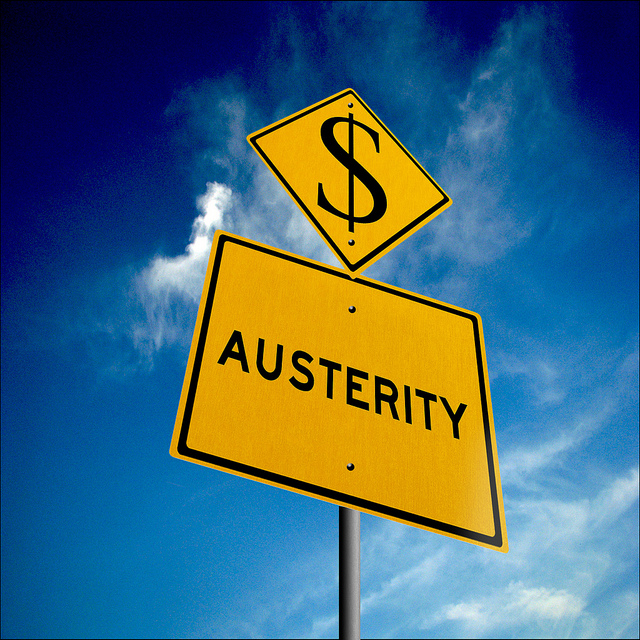In August 2011, the U.K.’s The Independent stated that the head of sovereign ratings at Standard & Poor’s (S&P) “might be the most powerful man in the world that you’ve never heard of.” S&P had just cut the triple-A credit rating of the U.S. down to AA+, a move that “changed the financial world.”
The writer noted that “…there is a direct line from S&P’s rulings to the cuts that governments around the world are imposing on their citizens. You might not have heard of him [David T. Beers, now no longer with S&P], but Treasury officials and finance minister all over the world certainly have, and they fear S&P’s judgement.”
The link between austerity budgets being imposed across Europe and the sovereign ratings given by the Big Three credit ratings agencies (CRAs) — Moody’s, S&P and Fitch — was here being made explicit. “No one elected Mr. Beers, and S&P’s pivotal role in financial markets has grown up only over many generations, but here he is at the centre of the debt storm engulfing the eurozone and now the U.S. — under fire from politicians on both sides of the Atlantic.”
In 2010, one or more of the Big Three CRAs had cut the sovereign ratings of Greece, Portugal and Ireland to “junk” status — a move that many EU officials say accelerated the European financial crisis. By 2012, S&P had downgraded another nine European states, leaving only Germany in the 17-nation eurozone with a triple-A rating.
When Moody’s announced a “negative outlook” for the UK’s triple-A rating in 2012, a writer for the U.K.’s The Guardian explained, “The lower their outlook, the more likely Moody’s thinks the U.K. government is to default on its debts — and the less likely it is that people…will want to lend it money. The lenders that do remain will be more nervous about the prospects of getting their money back — and so they’ll charge higher interest rates. And the higher the interest rates, the steeper the government’s debt repayments, and the more likely it is to default. And so it goes on. It is an Escherian cycle, and one in which the credit ratings agencies — many argue — play too powerful a role.”
By that time, critics had recognized that the CRA downgrades of various nations’ sovereign debt were forcing governments to further deregulate, privatize and otherwise cave in to right-wing neoliberal economic agenda. In the Third World, this had been called “structural adjustment programs;” in the developed world: austerity budget cutting.
As financial analyst Matt Stoller explained in 2011 just after S&P’s cut to the U.S. credit rating, “While it’s useful to think of the ratings agencies as incompetent, or as greedy, it’s important to remember that they have an actual policy agenda… The goal of S&P is to ensure that there is a bipartisan set of spending cuts to social programs that benefit ordinary people. That their ‘downgrade’ is being taken seriously by Nancy Pelosi, Barack Obama, John Boehner, Rob Reich, Dick Durbin, and most American political leaders shows that they share this goal. S&P is just doing the lobbying work.”
Stoller also revealed that the CRAs, especially S&P, “weren’t just wrong in rating subprime tranches of toxic dreck AAA. They were also pivotal in actively creating the policies that led to the financial crisis.”
Stoller referred to information documented in the book Reckless Endangerment by Josh Rosner and Grethchn Morgenson, who found that in the early 2000s, several U.S. states had attempted to stop the wave of predatory mortgage lending sweeping across that country. Consumer advocates had recognized the dangerous trend and attermpted to enact fair lending legislation. As Stoller put it, these state laws “would have threatened the highly profitable mortgage securitization pipeline. S&P used its power to destroy this threat” by “killing mortgage servicing regulation and rules to prevent fraudulent or predatory mortgage lending.”
Ruling the world
The Big Three CRAs “have a power over governments and corporations that far outranks any influence you or I as voters or workers might have,” wrote Aditya Chakrabortty in the U.K.’s The Guardian in 2012. He argued that “the agencies are neither accurate nor merely observers — yet they bully governments around the world and make billions doing so.” In a suggestion that must have sent chills through Big Three CRA offices worldwide, he wrote, “Let’s have a ratings agency run by the UN, funded by pooled contributions from both lenders and borrowers. It should be the only one to have preferential access to data from corporate and countries. Let’s make the ratings business a [public] utility, rather than a semi-cartel that intimidates elected politicians and rakes in excess profits. It’s time to break up the bullying double-act” of Moody’s and S&P.
When the U.S. Justice Department in 2013 launched a $5 billion civil lawsuit against S&P for its role in the financial meltdown, even Time magazine was asking, “Is it Time to Rethink the Role of Ratings Agencies?”
As we shall see, Europe is taking some steps to curb the power of the CRAs, but so far, in North America nothing much has been done. That benefits one billionaire in particular, who has his sights trained on Canada.
Read part one of Joyce Nelson’s series: ‘Debunking the Bogeyman: What role do credit ratings agencies actually play?‘
Joyce Nelson is an award-winning freelance writer/researcher and the author of five books.
Photo: flickr/401(K) 2012



